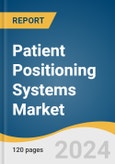The global Patient Positioning Systems market size is expected to reach USD 59.42 billion by 2025, registering CAGR of 8.0% from 2024 to 2030. This market is expected to witness lucrative growth owing to rising awareness about and surging expenditure on diagnostic procedures. In addition, the increasing prevalence of cancer and the rising geriatric population are expected to assist in market growth.
The COVID-19 pandemic has made unprecedented consequences on daily lives in addition to the worldwide economy. A significant burden is formed on healthcare systems across the globe. Currently, as the pandemic starts to subside, governments of various countries are focusing on recognizing the cracks in their healthcare infrastructure and are taking initiatives to bolster the same. The market is projected to benefit from this up-gradation of healthcare establishments across the world. For instance, in December 2020, Victorian hospitals received financial support to upgrade infrastructure and equipment.
According to the WHO, Cancer is a leading cause of death globally, reporting for almost 10 million deaths in 2020, or nearly one in six deaths. While as per the National Cancer Institute statistics, there were approximately 16.9 million cancer survivors in the U.S. as of January 2019. The number of cancer survivors is expected to increase to 22.2 million by 2030. The most common types of cancer are breast cancer, prostate cancer, and colon and rectum cancer. This steady increase in disease prevalence acts as a driver for R&D investments in the industry. An increase in innovation has resulted in improved efficiency and accuracy of these systems in cancer therapy. These products keep patients immobile yet comfortable during radiotherapy. This is anticipated to supplement industry growth.
Rising expenditure on diagnostics procedures has been a strong force driving demand in the market. According to research published by NCBI, the majority of oncologists and cardiologists in the U.S. and Germany prescribe diagnostics tests and choose a treatment plan only after studying test results. Thus, the demand for diagnostics tests is increasing globally.
The COVID-19 pandemic has made unprecedented consequences on daily lives in addition to the worldwide economy. A significant burden is formed on healthcare systems across the globe. Currently, as the pandemic starts to subside, governments of various countries are focusing on recognizing the cracks in their healthcare infrastructure and are taking initiatives to bolster the same. The market is projected to benefit from this up-gradation of healthcare establishments across the world. For instance, in December 2020, Victorian hospitals received financial support to upgrade infrastructure and equipment.
According to the WHO, Cancer is a leading cause of death globally, reporting for almost 10 million deaths in 2020, or nearly one in six deaths. While as per the National Cancer Institute statistics, there were approximately 16.9 million cancer survivors in the U.S. as of January 2019. The number of cancer survivors is expected to increase to 22.2 million by 2030. The most common types of cancer are breast cancer, prostate cancer, and colon and rectum cancer. This steady increase in disease prevalence acts as a driver for R&D investments in the industry. An increase in innovation has resulted in improved efficiency and accuracy of these systems in cancer therapy. These products keep patients immobile yet comfortable during radiotherapy. This is anticipated to supplement industry growth.
Rising expenditure on diagnostics procedures has been a strong force driving demand in the market. According to research published by NCBI, the majority of oncologists and cardiologists in the U.S. and Germany prescribe diagnostics tests and choose a treatment plan only after studying test results. Thus, the demand for diagnostics tests is increasing globally.
Patient Positioning Systems Market Report Highlights
- By product, the tables segment held a lucrative market share in 2023, owing to the increasing prevalence of cancer and the rising number of surgeries performed
- In terms of application, the surgery segment is expected to account for the dominant market share on account of the rising incidence of cancer, globally
- By end-use, the ambulatory segment is expected to register the highest growth over the forecast period owing to an increase in precision of minimally invasive technologies
- North America is projected to dominate the market over the forecast period due to the presence of a large number of diagnostic centers
- The market is fragmented with many big and small industry players. Key players are adopting business strategies such as business expansion, joint ventures, and others
Table of Contents
Chapter 1. Methodology and Scope
Chapter 2. Executive Summary
Chapter 3. Patient Positioning Systems Market Variables, Trends & Scope
Chapter 4. Patient Positioning Systems Market: Product Estimates & Trend Analysis
Chapter 5. Patient Positioning Systems Market: Application Estimates & Trend Analysis
Chapter 6. Patient Positioning Systems Market: End-use Estimates & Trend Analysis
Chapter 7. Patient Positioning Systems Market: Regional Estimates & Trend Analysis
Chapter 8. Competitive Landscape
List of Tables
List of Figures
Companies Mentioned
- Medtronic
- Hill-Rom Holdings, Inc.
- Stryker Corporation
- Medline Industries
- Skytron, LLC
- Smith & Nephew
- STERIS plc
- Mizuho OSI
- LEONI AG
- OPT SurgiSystems Srl
Methodology

LOADING...








